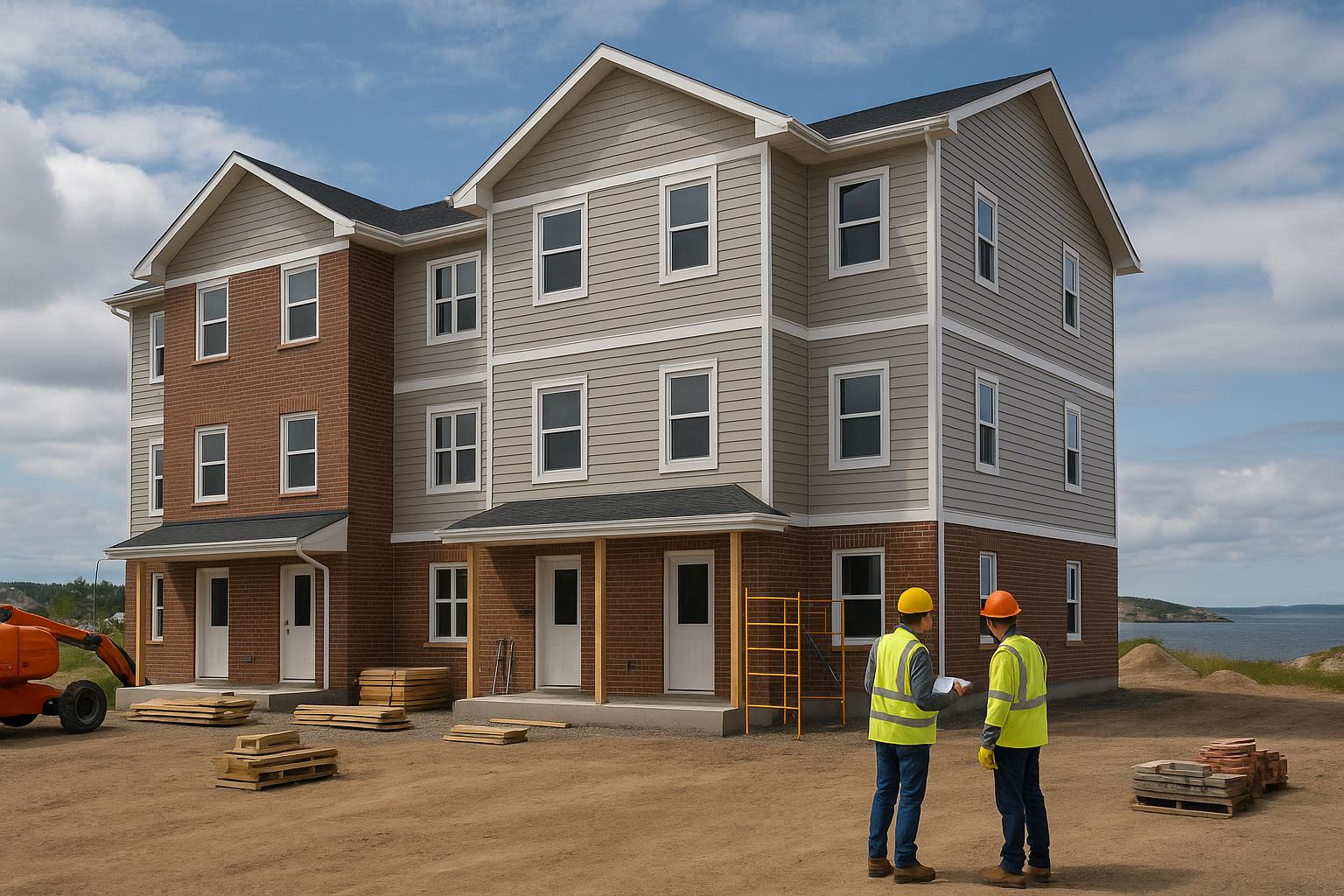Building multi-unit properties near Halifax's ER zones under the Centre Plan requires careful attention to zoning rules and neighbour relations. Here's what you need to know:
- Stepbacks: Buildings in COR zones next to ER zones must have specific horizontal recesses to reduce visual impact. These include 6.0-metre setbacks and additional stepbacks for buildings over 11 metres.
- Shadows: Developers must conduct shadow studies to ensure new buildings don't block sunlight for more than 4 continuous hours in public spaces on key dates.
- Privacy: Thoughtful window placement, orientation, and landscaping are essential to maintain privacy for neighbouring properties.
Using an integrated design-build approach simplifies the process by addressing these requirements early, ensuring smoother approvals, better coordination, and reliable timelines.
Lawyer Explains Property Setbacks | EVERYTHING to know about your property lines.
Stepbacks: Meeting Rules and Keeping Neighbours Happy
Stepbacks play a key role in designing multi-unit buildings that fit harmoniously next to Established Residential (ER) neighbourhoods. They help ensure new buildings feel less overwhelming to nearby homes while aligning with Halifax's Centre Plan guidelines.
Stepback Rules in COR Zones
In COR zones that border ER areas, specific stepback rules apply. According to the Centre Plan's Land Use By-law, a stepback is defined as a horizontal recess that breaks the vertical plane of an exterior wall on a main building [1].
These rules aren’t optional - they’re essential. Buildings must include a 6.0-metre side yard setback and a 6.0-metre rear yard setback when next to ER zones [2]. Once a building exceeds 11 metres in height, additional stepbacks kick in: 2.5 metres for mid-rise buildings and 3.5 metres for high-rise buildings [2].
Municipal planners will carefully review these measurements as part of your application. Stepbacks work in tandem with a "streetwall", which the by-law defines as the wall of a building or portion of a wall facing a streetline below the height of a specified stepback [1].
Additionally, an L2 Screen Landscaped Buffer is required along the property line. This buffer must include evergreen shrubs and trees that form an opaque barrier, with one tree for every 4.5 metres of buffer length. It also requires a 1.8-metre-high opaque barrier made of wood or masonry fencing [2]. These elements not only protect neighbour privacy but also enhance the overall look of the development.
How to Design Good Stepbacks
While meeting the legal requirements is essential, thoughtful stepback design can elevate a project and reduce its impact on neighbouring properties.
Tiered building forms are particularly effective in Halifax. Instead of one large stepback at a set height, consider using several smaller stepbacks to create a gradual transition. This approach softens the visual impact, making the building appear to "step down" toward the ER zone.
Facade treatments can further enhance stepbacks. Using contrasting materials or colours on stepped portions of the building creates visual interest. Lighter colours or varied textures on upper floors can make the building appear less bulky.
Landscaping integration is another way to make stepbacks more effective. Connect the required L2 buffer with your stepback design by planting taller trees near the building and shorter shrubs closer to the property line. This layered approach adds depth and complements the stepped profile of the building.
Functional stepbacks can also add value. Upper-floor stepbacks can serve as private balconies or terraces, creating outdoor spaces for tenants while meeting by-law requirements. At ground level, stepbacks can accommodate landscaped courtyards or shared amenities. These strategies not only comply with regulations but also enhance the building’s appeal and minimize its impact on neighbours.
How Integrated Design-Build Firms Handle Stepback Rules
Traditional project approaches often struggle with stepback requirements due to fragmented coordination among architects, engineers, and builders. Each professional focuses on their part of the project, which can lead to delays and budget issues when stepback rules aren’t considered holistically.
Integrated design-build firms solve this problem by bringing all disciplines under one roof. At Helio Urban Development, for example, the architectural team designs stepbacks with full knowledge of how the construction team will execute them and what engineering constraints exist.
This integrated approach avoids structural challenges and budget overruns. It also streamlines municipal approvals. When design and construction teams understand both the regulations and the practicalities, they produce plans that meet municipal standards on the first submission, cutting out the back-and-forth revisions that can drag out timelines.
Fixed-price construction becomes more achievable when stepback requirements are accounted for from the start. Unlike traditional builders, who often view stepbacks as costly extras, integrated firms include these elements in their base pricing because they are part of the initial design process.
This coordination becomes even more critical when stepback requirements intersect with other Centre Plan rules, like shadow studies and privacy measures. Integrated teams can address all these factors simultaneously, avoiding conflicts and ensuring the project moves forward smoothly.
Reducing Shadow Problems: Practical Design Methods
To maintain a good quality of life and comply with municipal regulations, it's essential to address shadow impacts on nearby properties. Below are the key requirements for shadow studies that your project must meet.
Municipal Shadow Study Rules
In Halifax, most multi-unit developments in COR zones must include a Shadow Impact Assessment as per municipal guidelines. The Proposed Centre Plan (June 2021) explains:
"A Shadow Impact Assessment documents a development's effect on sunlight in key public spaces." [3]
This assessment is required for any development located within 100 metres of a defined boundary (excluding low-density homes) or for buildings taller than 26 metres [3]. The study must demonstrate that, on September 21, between 08:00 and 18:00, public spaces receive at least 6 hours of sunlight and no single area experiences more than 4 continuous hours of shade [3].
Your shadow study submission should include detailed diagrams showing shadow impacts at key times along the building envelope. These diagrams must incorporate contextual features such as streets, property lines, and public spaces. Additionally, your submission should include a brief analysis and a property survey [3].
Privacy: Keeping ER Neighbours Comfortable
Privacy plays a key role when designing multi-unit buildings near established residential areas. While issues like stepbacks and shadow impacts are governed by clear municipal guidelines, privacy often falls into a more subjective realm. Addressing potential privacy concerns early in the design process can prevent future disputes and help build goodwill with your neighbours. This aspect of planning complements the stepback and shadow strategies discussed earlier.
Identifying Privacy Concerns Early
Since municipal guidelines don’t always provide specific direction on privacy, it’s smart to start with a thorough site review. This might involve walking through neighbouring properties to understand how your proposed building interacts with the surrounding homes. By doing this early, you can ensure your design aligns with both your project’s goals and the comfort of nearby residents.
Privacy-Focused Design Strategies
Thoughtful building design can go a long way in maintaining privacy. Work with an experienced design team to carefully plan the building's orientation and window placement. These decisions can reduce the feeling of intrusion for neighbours while ensuring the building serves its functional purpose. Considering privacy from the outset helps create a project that respects the established character of the area.
Landscaping as a Privacy Tool
Landscaping can complement architectural efforts by providing natural privacy screens. A mix of greenery, fencing, and other landscape elements can create effective barriers between properties. Proper planning and maintenance of these features ensure they provide long-term privacy while blending seamlessly with the overall design of the project. Together, these measures help balance functionality with neighbourhood harmony.
sbb-itb-16b8a48
Benefits of an Integrated Design-Build Approach
When developing multi-unit properties near existing residential areas, challenges like stepbacks, shadow impacts, and privacy concerns can get tricky. An integrated design-build approach helps tackle these issues head-on by bringing all the expertise you need under one roof. This not only simplifies the process but also makes it easier to stay on top of regulatory requirements, boosting efficiency and reducing headaches.
Simplified Coordination and Better Results
Working with separate architects, engineers, planners, and contractors can feel like herding cats. An integrated team, on the other hand, is already aligned on local rules and quality expectations. This unified approach ensures consistent oversight and allows for quicker adjustments when needed. The result? Smoother coordination, better cost control, and timelines that actually stick.
Fixed-Price Contracts and Reliable Timelines
One of the standout advantages of the integrated design-build model is cost certainty. With fixed-price contracts and guaranteed timelines - often backed by penalty clauses - you won’t have to worry about surprise expenses or drawn-out delays. For property owners, this means you can plan for rental income with confidence, knowing your project is on track and on budget. These features make a clear case for choosing this approach over traditional construction methods.
Comparing Integrated and Traditional Construction Methods
| Aspect | Traditional Fragmented Approach | Integrated Design-Build Approach |
|---|---|---|
| Risk Management | Coordination issues across multiple teams | Single company handles all coordination |
| Cost Certainty | Cost-plus pricing with frequent overruns | Fixed-price contracts with no overruns |
| Timeline Predictability | Often stretches from 8 to 18+ months | Predictable timelines with penalties for delays |
| Compliance | Separate management for each contract | One point of contact for all regulations |
| Quality Control | Varies between contractors | Consistent quality with regular inspections |
Conclusion: Key Points and Next Steps
Building multi-unit properties near ER zones in COR areas doesn't have to be complicated - if you start with the right plan. Success hinges on mastering the basics: stepbacks, shadow management, and privacy solutions.
Main Methods for Building Next to ER Areas
Here are three key strategies to ensure your project fits seamlessly into the neighbourhood:
- Stepbacks for smooth transitions: Gradual stepbacks and varied rooflines help blend your building into the surrounding area. These techniques reduce the visual impact of larger structures, making them more appealing to neighbours.
- Minimizing shadows: Thoughtful orientation and massing are essential to limit shadows on nearby properties. By tweaking your design early in the process, you can avoid creating unwanted shade and maintain good relations with the community.
- Protecting privacy: Architectural features and landscaping can work together to manage sightlines and maintain privacy. This approach helps prevent conflicts with neighbours down the road.
These principles form the backbone of a well-executed project.
Why an Integrated Builder Makes a Difference
To bring these strategies to life, working with an integrated builder can simplify the process and improve results. Instead of juggling separate architects, engineers, and contractors, an integrated design-build approach combines all expertise under one roof. This eliminates miscommunication and ensures accountability throughout the project.
For example, Helio Urban Development, Nova Scotia's only integrated design-build firm for rental properties with four or more units, is a proven leader in this approach. With 31 units currently under construction and 131 more in planning, they demonstrate how streamlined collaboration leads to success. Their model includes fixed-price contracts, clear timelines, and daily photo updates. Plus, with triple quality checks by P.Eng inspectors and financial penalties for delays, property owners can trust their projects will stay on track.
If you're planning to build near established residential areas, the formula is straightforward: Combine smart design strategies like stepbacks, shadow control, and privacy measures with an integrated builder who understands both municipal rules and neighbourhood needs. This approach not only speeds up approvals but also reduces disputes and ensures timely rental income.
FAQs
How does a design-build approach help meet stepback, shadow, and privacy requirements in COR zones?
The design-build method simplifies meeting stepback, shadow, and privacy requirements in COR zones by encouraging early teamwork among architects, engineers, and builders. This collaboration ensures zoning rules are factored in from the beginning, cutting down the chances of expensive changes later.
By addressing these requirements early in the design phase, this approach makes it easier to solve problems and stick to municipal guidelines. It promotes designs that reduce shadow effects, protect privacy, and align with the community's character, all while enhancing the development's potential for rental success.
How can property owners design buildings in Halifax's COR zones to reduce shadow impacts on public spaces?
Reducing Shadow Impacts in Halifax's COR Zones
In Halifax's COR zones, managing shadow impacts starts with smart design choices. By carefully shaping and orienting buildings, property owners can reduce shadowing during critical sunlight hours, especially in the afternoon. Using stepped or terraced designs is another effective approach, as it breaks up shadow patterns and limits shading on nearby public areas.
Getting a shadow impact assessment done early in the planning phase is key. These assessments help developers tweak building height, orientation, and overall structure to align with municipal rules while considering the needs of the community. A well-thought-out design doesn’t just improve shared spaces - it also helps buildings blend more harmoniously into the neighbourhood.
How can window placement and landscaping improve privacy in multi-unit developments near ER zones?
When planning multi-unit developments near environmentally restricted (ER) zones, privacy can be significantly improved through careful window placement and smart landscaping. For instance, positioning windows to avoid direct views into neighbouring properties and using dense greenery - such as trees, shrubs, or privacy screens - can help create a more secluded and comfortable environment for both residents and neighbours.
Additionally, raising ground-floor units and introducing landscaped buffer zones between buildings are effective ways to reduce sightlines. These thoughtful design elements not only enhance privacy but also promote a sense of community and harmony within the neighbourhood, striking a balance between development goals and maintaining good relationships.



